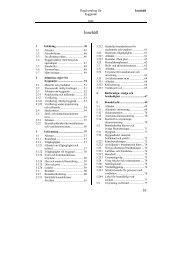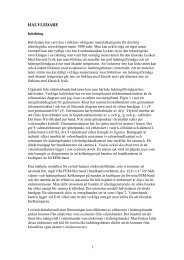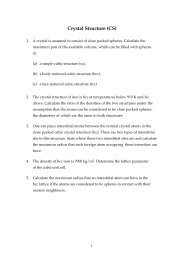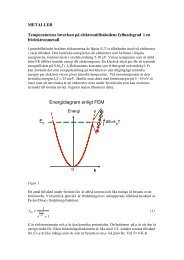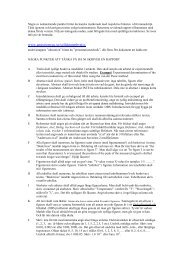You also want an ePaper? Increase the reach of your titles
YUMPU automatically turns print PDFs into web optimized ePapers that Google loves.
Unipolar Devices III:<br />
<strong>GaN</strong> Electronic Devices<br />
Tutorial in the frame of the TARGET network<br />
Joachim Würfl<br />
Ferdinand-Braun-Institut für<br />
Höchstfrequenztechnik<br />
Gustav-Kirchhoff-Straße 4<br />
12489 Berlin<br />
Participating institutions:<br />
� Fraunhofer Institut für angewandte<br />
Festkörperphysik, Freiburg, Germany<br />
� Technical University Vienna, Austria<br />
� AMS, Rome, Italy<br />
...Translating ideas into innovation<br />
IAF<br />
Fraunhofer Institut<br />
Angewandte<br />
Festkörperphysik
Outline<br />
<strong>GaN</strong> electronic <strong>devices</strong> –<br />
An introduction<br />
Device fabrication<br />
Understanding device<br />
operation<br />
Design of high power<br />
microwave <strong>GaN</strong> <strong>devices</strong><br />
Future <strong>GaN</strong> <strong>devices</strong><br />
Conclusions<br />
� Comparison to other device families<br />
� Applications<br />
� Principles of operation<br />
� Epitaxy<br />
� Processing<br />
� Performance limitations and how to get rid of it<br />
� Reliability<br />
� Field plate <strong>devices</strong><br />
� Power bar designs<br />
� State of the art results<br />
� Novel epitaxial approaches<br />
� <strong>GaN</strong> HBTs
<strong>GaN</strong> electronic <strong>devices</strong><br />
– An introduction
Semiconductor microwave power <strong>devices</strong><br />
maximale maximale Leistung Leistung (Watt) (Watt)<br />
Maximum power (W)<br />
1000<br />
100<br />
10<br />
1<br />
SiC <strong>GaN</strong> HFET<br />
SiC <strong>GaN</strong> HFET<br />
Si LDMOS GaAs HBT, HEMT<br />
Si LDMOS GaAs HBT, HEMT<br />
0,1<br />
0,1 1 10 100 1000<br />
Frequency Frequenz (GHz) (GHz)<br />
InP HBT, HEMT<br />
InP HBT, HEMT<br />
Device classes and frequency vs. maximum possible<br />
microwave power
Comparison of semiconductor materials<br />
Band Gap (eV)<br />
Electron mobility<br />
(cm²/Vs)<br />
Electric breakdown field<br />
(10 6 V/cm)<br />
Saturation velocity<br />
(10 7 cm/s)<br />
Thermal conductivity<br />
(W/Kcm)<br />
Johnsons Figure of Merit<br />
(~V Br ² x v sat ²)<br />
Maximum estimated operation<br />
temperature (°C)<br />
Si<br />
1.1<br />
ind.<br />
1500<br />
0.3<br />
1.0<br />
1.5<br />
1<br />
200<br />
GaAs<br />
1.43<br />
dir.<br />
8500<br />
0.4<br />
2.0<br />
0.46<br />
7<br />
300<br />
4H-SiC<br />
3.26<br />
ind.<br />
1000<br />
2.0<br />
2.0<br />
4.9<br />
180<br />
500<br />
6H SiC<br />
3.0<br />
ind.<br />
500<br />
2.4<br />
2.0<br />
4.9<br />
260<br />
500<br />
<strong>GaN</strong>/<br />
Al<strong>GaN</strong><br />
3.42<br />
dir.<br />
1250*<br />
3.3<br />
2.7<br />
1.3<br />
760<br />
500<br />
* 2DEG mobility up to 2000 cm²/Vs
Applications<br />
Oscillator<br />
1/f noise<br />
Distortion<br />
RF noise<br />
High power amplifier<br />
Low noise amplifier<br />
Breakdown<br />
Voltage<br />
High speed communication Gate array<br />
f max<br />
Power<br />
Handling<br />
f T<br />
P diss<br />
ADC ASIC Air cooled LSI<br />
g m<br />
σVT<br />
GaAs - HEMT<br />
GaAs - HBT<br />
Si - BJT<br />
<strong>GaN</strong> - HEMT
<strong>GaN</strong> high power <strong>devices</strong>: Applications<br />
Demands from system<br />
applications<br />
More demanding<br />
requirements regarding:<br />
� Linearity<br />
� Output power<br />
� Efficiency<br />
� Heat sinking<br />
� Total system noise factor<br />
To be expected in future:<br />
Realization in <strong>GaN</strong> technology<br />
<strong>GaN</strong> <strong>devices</strong> for<br />
„Enabling microwave components“<br />
� High power microwave amplifier (HPA)<br />
� Highly linear amplifiers<br />
� Robust low noise amplifiers (LNA)<br />
� Power switches<br />
Civil applications<br />
� Base stations for mobile communications<br />
� Satellite communication<br />
Military applications<br />
� Phased array radar systems
Advantages of <strong>GaN</strong>-HFETs in power amplifiers<br />
conventional technology <strong>GaN</strong> technology<br />
T T<br />
T<br />
T<br />
T T<br />
T T<br />
input T T<br />
output input output<br />
T<br />
T T<br />
T<br />
Higher operation voltage leads to:<br />
� Higher power densities<br />
� Higher impedance level<br />
� Higher linearity<br />
� Less complex transformation and power combining networks<br />
Less complex circuit design<br />
� Small chip areas<br />
� Higher reliability
III-Nitride hetero structures for<br />
microwave power transistors<br />
R.J.. Trew, MTT-S 2004<br />
Bandgap-Engineering<br />
� Realization of HEMTs<br />
Spontaneous and<br />
piezoelectric polarization<br />
Advantages:<br />
� Reduced Coulomb-<br />
Scattering in 2DEG<br />
� Higher mobility<br />
� Higher carrier<br />
concentration in 2DEG
High Electron Mobility Transistors (HEMT):<br />
How does it work?<br />
Source<br />
AlGaAs<br />
Gate<br />
Drain<br />
GaAs 2-DEG<br />
spacer<br />
AlGaAs GaAs<br />
Distribution<br />
of 2DEG carriers<br />
Additional<br />
features<br />
Example: GaAs/AlGaAs HEMTs<br />
� Electrons from AlGaAs drift to<br />
AlGaAs/GaAs interface<br />
� There: Formation of 2DEG<br />
� Extremely high electron mobility<br />
along interface<br />
� 2DEG concentration controllable by<br />
Gate electrode<br />
Speciality: <strong>GaN</strong>/Al<strong>GaN</strong> HEMT<br />
� Parameters controlling 2DEG<br />
concentration:<br />
-Doping of Al<strong>GaN</strong> barrier<br />
-Spontaneous polarization<br />
-Piezoelectric polarization
Spontaneous and piezoelectric polarization<br />
Relaxed<br />
Substrate<br />
Compressive<br />
strain<br />
Substrate
Mechanism of spontaneous polarization<br />
Charge distribution of<br />
valence electrons (e/ų)<br />
Ionic character of<br />
Ga-N compound<br />
+<br />
Deviation from ideal<br />
c/a ratio<br />
Resulting<br />
polarization<br />
Spontaneous<br />
polarization
c/a ratio<br />
c/a-ratio and spontaneous polarization<br />
Spont. polarization (C/m²)<br />
� c/a ratio always smaller as in ideal case<br />
� Spontaneous polarization increases in the order <strong>GaN</strong>, InN, Al<strong>GaN</strong><br />
� Relevant for high power <strong>GaN</strong> microwave transistors:<br />
Difference between <strong>GaN</strong> and Al<strong>GaN</strong>
Principles of 2DEG formation in Al<strong>GaN</strong>/<strong>GaN</strong> structures<br />
E F<br />
Al x Ga 1-x N<br />
P piezo<br />
∆P 0<br />
2DEG<br />
<strong>GaN</strong><br />
∇<br />
∆P 0 = P 0 (<strong>GaN</strong>)- P 0 (Al<strong>GaN</strong>)<br />
differential spontaneous polarization at the<br />
junction<br />
P piezo<br />
Gauss theorem: -ρ total = . (P piezo + P 0 )<br />
positive polarization-induced charge ρtotal to compensate ρtotal tensile strain in the<br />
Al<strong>GaN</strong> lattice-matched to <strong>GaN</strong><br />
2DEG accumulation<br />
polarization doping no intentional doping necessary !
2DEG formation in Al<strong>GaN</strong>/<strong>GaN</strong> HFET-structures<br />
<strong>GaN</strong><br />
Al<strong>GaN</strong><br />
<strong>GaN</strong><br />
Saphir<br />
P SP<br />
P SP<br />
P SP<br />
P PE<br />
-<br />
+<br />
ρ+<br />
N<br />
Ga<br />
O<br />
Al<br />
E F<br />
[0001]<br />
E C<br />
2DEG<br />
[0001]<br />
Ga-face polarity N-face polarity<br />
P SP<br />
P SP<br />
P SP<br />
P PE<br />
+<br />
-<br />
ρ+<br />
Ga<br />
N<br />
O<br />
Al<br />
E F<br />
E C<br />
2DEG
Device fabrication
Epitaxy on non-lattice matched substrates (1)<br />
Possible substrate solutions for <strong>GaN</strong> FETs:<br />
Lattice mismatch (%)<br />
Availability / Price (2“, $)<br />
Thermal Conductivity<br />
(W/cmK)<br />
Sapphire<br />
13<br />
100<br />
0.3<br />
n-type<br />
SiC<br />
3.1<br />
500<br />
4<br />
s.i.<br />
SiC<br />
3.1<br />
3000<br />
4<br />
<strong>GaN</strong> bulk<br />
0<br />
not<br />
available<br />
1.3<br />
IAF<br />
Fraunhofer Institut<br />
Angewandte<br />
Festkörperphysik<br />
Si<br />
17<br />
100<br />
1.48
Epitaxy on non-lattice matched substrates (2)<br />
Analysis of dislocations and epitaxial quality<br />
dislocations � TEM image<br />
Non-lattice matched substrate (sapphire)<br />
IAF<br />
Fraunhofer Institut<br />
Angewandte<br />
Festkörperphysik<br />
� PEC: photo enhanced etching<br />
� Dislocations are etched slower than<br />
defect free areas<br />
� Dislocation rich area up to a thickness<br />
of 500 nm
Epitaxy on non-lattice matched substrates (3)<br />
Metal Organic Chemical<br />
Vapour Deposition (MOCVD)<br />
Both types deliver similar epitaxial quality<br />
MOCVD:<br />
� Faster growth<br />
� Mass production<br />
Molecular Beam Epitaxy<br />
(MBE)<br />
MBE:<br />
� More options for polarity of<br />
interfaces<br />
IAF<br />
Fraunhofer Institut<br />
Angewandte<br />
Festkörperphysik
Impact of epitaxy on polar hetero<strong>devices</strong><br />
� Material composition x:<br />
Increasing n s while<br />
preserving mobility µ<br />
� No/little doping required<br />
Source<br />
Al x Ga 1-x N<br />
Al x Ga 1-x N<br />
Gate<br />
Drain<br />
Si-doping<br />
<strong>GaN</strong> 2-DEG<br />
Mobility (cm 2 / Vs)<br />
Sheet Carrier Concentration (1E13 cm -2 )<br />
1.8<br />
1.6<br />
1.4<br />
1.2<br />
1.0<br />
0.8<br />
0.6<br />
0.4<br />
0.2<br />
0.0<br />
1600<br />
1400<br />
1200<br />
1000<br />
800<br />
600<br />
400<br />
200<br />
0<br />
25 30<br />
Al content (%)<br />
35<br />
HEMT on Sapphire<br />
Al=25%<br />
Al=30%<br />
Al=35%<br />
0.4 0.6 0.8 1.0 1.2 1.4 1.6<br />
Sheet Carrier Concentration (1E13 cm -2 )<br />
IAF<br />
Fraunhofer Institut<br />
Angewandte<br />
Festkörperphysik
Technology of Al<strong>GaN</strong>/<strong>GaN</strong> HFETs (1)<br />
S D<br />
S D<br />
Ti-reflector layer on transparent wafer<br />
� Structuring of reflector layer<br />
� Definition of alignment marks<br />
Deposition of Source-/Drain contacts<br />
(Ti/Al/Ti/Au/WSiN)<br />
� Removal of reflector layer<br />
� Annealing at 850°C in N 2<br />
On chip isolation:<br />
� Dry etching of active layers<br />
� RIE-process, BCl 3 :Cl 2 :Ar
Technology of Al<strong>GaN</strong>/<strong>GaN</strong> HFETs (2)<br />
Dielectric<br />
passivation<br />
S G D<br />
S G D<br />
MIM-capacitor<br />
Resistor<br />
Gate-Technology (Pt-Au):<br />
� Electron beam lithography:<br />
Gate length 0.3 µm<br />
Passivation and dry etching of contact<br />
windows<br />
1 st interconnect (Ti-Pt-Au, 500nm)<br />
Passive components:<br />
� MIM-capacitor<br />
� NiCr-resistor<br />
� Electroplated Au air bridge<br />
(6 µm)
Technology of Power Cells<br />
WSiN x -Diffusionbarrier<br />
encapsulats ohmic contact<br />
Power cell with common Source Design<br />
(connected by airbridge)
Backend Processing<br />
Wafer thinning<br />
Via etching and<br />
metalization<br />
Chip dicing
Backend Processing (1)<br />
Thinning of SiC-Substrate to 100 µm<br />
� Lapping with different diamond<br />
pastes<br />
� Polishing<br />
Via technology<br />
� Dry chemical via process<br />
� Laser micro-machining<br />
Via metallization<br />
� Plating base: Ti/Au 30/1000 nm<br />
Electroplating
Backend Processing (2)<br />
Definition of dicing streets<br />
� Lithography and etching<br />
� Laser micro-machining<br />
Wafer dicing<br />
� Sawing and cleaving<br />
Chip delivery:<br />
� Diced chips on dicing frame
L-Band Powerbars based on laser-vias<br />
� Full wafer thickness<br />
(Wafer not thinned)<br />
� Via-diameter 90 µm<br />
� Technological specialty<br />
Through-Vias
Chip Dicing<br />
Laser scribe lines<br />
Laser induced removal of Au in<br />
dicing streets<br />
(focus on backside)<br />
Dicing street<br />
Dicing street after wafer sawing<br />
and cleaning<br />
(focus on front side)
<strong>GaN</strong>-HFETs:<br />
Power <strong>devices</strong> on transparent wafers
16x250 µm power cells<br />
Device data at 2 GHz:<br />
� P max = 12.3 W<br />
� PAE = 59%<br />
� Linear gain: 19 dB<br />
� Gain at P max : 16 dB<br />
dB MSG<br />
Po(dBm); G(dB); PAE<br />
(%)<br />
40<br />
30<br />
20<br />
10<br />
0<br />
60<br />
50<br />
40<br />
30<br />
20<br />
10<br />
0<br />
0,1 1 10 100<br />
Pout<br />
G<br />
PAE<br />
ID<br />
f (GHz)<br />
Pmax=12.3W<br />
-10 0 10 20 30<br />
Pin (dBm)<br />
0,8<br />
0,7<br />
0,6<br />
0,5<br />
0,4<br />
0,3<br />
0,2<br />
0,1<br />
0<br />
ID (A)
Understanding device operation
I D (A)<br />
DC-characteristics<br />
Device:<br />
<strong>GaN</strong>-HFET 2x50 µm,<br />
L g = 0.3 µm<br />
0.12<br />
0.1<br />
0.08<br />
0.06<br />
0.04<br />
0.02<br />
0<br />
I D (A)<br />
0.12<br />
0.1<br />
0.08<br />
0.06<br />
0.04<br />
0.02<br />
0 5 10 15 20 25 30<br />
V DS (V)<br />
0<br />
-8 -7 -6 -5 -4 -3 -2 -1 0 1 2<br />
V GS (V)<br />
Typical <strong>GaN</strong>-HFET I/Vcharacteristics:<br />
� I DSS_max = 1.1 A/mm<br />
� g m = 220 mS/mm<br />
� Slight hysteresis in output<br />
characteristics
I (mA) ds<br />
Compression of drain current: Gate lag conditions<br />
140<br />
120<br />
100<br />
80<br />
60<br />
40<br />
20<br />
0<br />
0 5 10 15 20 25 30<br />
V (V)<br />
ds V = 0.0 V, V = 0.0 V<br />
gs ds<br />
V = -3.0 V, V = 0.0 V<br />
gs ds<br />
I (mA)<br />
ds 140<br />
120<br />
100<br />
80<br />
60<br />
40<br />
20<br />
0<br />
0 5 10 15 20 25 30<br />
V (V) ds<br />
V = 0.0 V, V = 0.0 V<br />
gs ds<br />
V = -3.0 V, V = 0.0 V<br />
gs ds<br />
Biasing point for pulse measurements: V GS = -3 V, (pinch off); V DS = 0 V<br />
Before passivation:<br />
� Drain current reduction<br />
After passivation<br />
� Slight recovery of drain current
Reduction of power dispersion (3)<br />
5. Field plate structures<br />
� Suppressing surface/interface traps<br />
� Field plate flattens electric field distribution<br />
G<br />
� High electric field<br />
� Trapped electrons<br />
form virtual gate<br />
Al<strong>GaN</strong><br />
+ + + + + + + + + + + + + + + + + + +<br />
<strong>GaN</strong><br />
Without field plate<br />
D<br />
� Electric field<br />
maximum reduced<br />
� Modulation of<br />
carriers due to F.P<br />
Al<strong>GaN</strong><br />
+ + + + + + + + + + + + + + + + + +<br />
<strong>GaN</strong><br />
With field plate<br />
D
I (mA)<br />
ds Compression of drain current: Drain lag conditions<br />
140<br />
120<br />
100<br />
80<br />
60<br />
40<br />
20<br />
0<br />
0 5 10 15 20 25 30<br />
V (V) ds<br />
V gs = -3.0 V, V ds = 0.0 V<br />
V gs = -3.0 V, V ds = 26.0 V<br />
I (mA) ds<br />
140<br />
120<br />
100<br />
80<br />
60<br />
40<br />
20<br />
V gs = -3.0 V, V ds = 0.0 V<br />
V gs = -3.0 V, V ds = 26.0 V<br />
0<br />
0 5 10 15 20 25 30<br />
V (V)<br />
ds Biasing point for pulse measurements: V GS = -3 V, (pinch off); V DS = 26 V<br />
Before passivation:<br />
� Very pronounced drain lag<br />
After passivation:<br />
� Strong recovery of drain lag
Maximum obtainable output power<br />
I DS<br />
V P<br />
g m<br />
I max<br />
V GS<br />
V K<br />
R opt = (V DSmax –V K ) / I max<br />
V GS =0<br />
V GS =V P<br />
P max = 1/2 · (V DSmax –V K ) · I max<br />
V DD<br />
V DSmax<br />
V DS<br />
Ohmic Saturation Breakdown<br />
∆I<br />
Optimum output impedance for<br />
max. output amplitude given by:<br />
� Voltage knee V K<br />
� Breakdown onset<br />
� Saturation current
If current compression:<br />
Strong reduction of maximum obtainable output power<br />
I DS<br />
V P<br />
g m<br />
Therefore:<br />
I max<br />
V GS<br />
V K<br />
Current compression has to<br />
reduced by any means<br />
V DSmax<br />
V DS<br />
Ohmic Saturation Breakdown<br />
Not accessible<br />
∆I<br />
Maximum power swing reduced by:<br />
� Surface traps<br />
� Buffer layer traps
I ds (mA)<br />
Dependency of output power density<br />
on current compression<br />
120<br />
100<br />
80<br />
60<br />
40<br />
20<br />
0<br />
0<br />
0<br />
0 5 10 15 20 25 30<br />
0 5 10 15 20 25 30<br />
0 5 10 15 20 25 30<br />
V ds (V)<br />
Static<br />
Dynamic<br />
0<br />
0<br />
0<br />
0<br />
0<br />
0<br />
V ds (V)<br />
Static<br />
Dynamic<br />
P out = 5.2 W/mm P out = 3.9 W/mm P out = 1.8 W/mm<br />
� Transistor geometry: 2x50 µm<br />
� Frequency: 2 GHz<br />
0<br />
0<br />
0<br />
0<br />
0<br />
0<br />
V ds (V)<br />
RF-power performance<br />
Static<br />
Dynamic
Physical background of current compression<br />
Main cause of current compression<br />
� Electron/hole traps due to<br />
surface/interface states & material<br />
defects<br />
Location of traps<br />
� Al<strong>GaN</strong> surface / interface (I)<br />
� Al<strong>GaN</strong> layer (II)<br />
� <strong>GaN</strong> buffer (III)<br />
� Interface substrate / buffer (IV)<br />
Causes of trap formation<br />
� Impurity addition during growth<br />
� Threading dislocation due to lattice<br />
mismatch & defects<br />
� Excess of carrier gasses & uncontrolled<br />
growth parameters<br />
� Increasing Al mole fraction and Al<strong>GaN</strong><br />
relaxation<br />
� Surface exposure & damage during<br />
device processing<br />
S<br />
G<br />
D<br />
(I) (I)<br />
Al<strong>GaN</strong> (II)<br />
<strong>GaN</strong> (III)<br />
IV<br />
Substrate
Current compression:<br />
An analogue from every days world<br />
� A parallelism could be made for a choked tap, that<br />
cannot modulate the flowing liquid (the Drain current)<br />
because of a throttling (the virtual Gate due to the<br />
charged traps) in the tube (the channel) before<br />
and/or after it.
Gate lag<br />
I ds (mA)<br />
Experimental observation Explanation<br />
70<br />
60<br />
50<br />
40<br />
30<br />
20<br />
10<br />
0<br />
0 5 10 15 20<br />
V ds (V)<br />
Bias points: V ds = 0.0 V; V gs = 0.0 V<br />
V ds = 0.0 V; V gs = -7.0 V<br />
Open channel: V ds = 0.0 V ; V gs = 0.0 V<br />
S D<br />
G<br />
Al<strong>GaN</strong><br />
+ + + + + + + + + + + + + + + + + + + + + + + + + + + +<br />
<strong>GaN</strong><br />
Depleted channel: V ds = 0.0 V ; V gs = -7.0 V<br />
� Pulsing the gate: ē are trapped in surface<br />
states, negative charging.<br />
S G<br />
D<br />
Al<strong>GaN</strong><br />
+ + + + + + + + + + + + + + + + + + + + + + + + + + + +<br />
<strong>GaN</strong><br />
Traps
I ds (mA)<br />
Drain lag<br />
Experimental observation Explanation<br />
70<br />
60<br />
50<br />
40<br />
30<br />
20<br />
10<br />
0<br />
0 5 10 15 20<br />
V ds (V)<br />
Bias points: V ds = 0.0 V; V gs = -7.0 V<br />
V ds = 20.0 V; V gs = -7.0 V<br />
Depleted channel: V ds = 0.0 V ; V gs = -7.0 V<br />
S D<br />
G<br />
Al<strong>GaN</strong><br />
+ + + + + + + + + + + + + + + + + + + + + + + + + + + +<br />
<strong>GaN</strong><br />
More Depleted channel:<br />
V ds = 20.0 V ; V gs = -7.0 V<br />
Traps<br />
Pulsing the drain: ē are also trapped in<br />
buffer traps due to high V ds.<br />
S G<br />
D<br />
Al<strong>GaN</strong><br />
+ + + + + + + + + + + + + + + + + + + + + + + + + + + +<br />
Traps
Reduction of power dispersion (1)<br />
1. Surface passivation<br />
2. n- type <strong>GaN</strong> cap<br />
Mechanism:<br />
� Neutralizing surface / interface traps by n + -donors (n-doped <strong>GaN</strong><br />
cap) & shallow donors (SiN x )<br />
� Therefore: No virtual gate formation<br />
G<br />
Al<strong>GaN</strong><br />
Trapped electrons<br />
form virtual gate<br />
+ + + + + + + + + + + + + + + + + + +<br />
<strong>GaN</strong><br />
D<br />
G<br />
Al<strong>GaN</strong><br />
Removal of virtual<br />
gate due to SiN x<br />
+ + + + + + + + + + + + + + + + + + +<br />
<strong>GaN</strong><br />
D<br />
Al<strong>GaN</strong><br />
G<br />
Removal of virtual gate<br />
due to n-doped cap<br />
+ + + + + + + + + + + + + + + + + + +<br />
<strong>GaN</strong><br />
D
Reduction of power dispersion (2)<br />
3. Recessed gate process<br />
4. Light stimulation<br />
� Suppression of surface/interface traps<br />
� No effective charging of surface states and therefore removal of virtual gate<br />
� De-trapping of carriers<br />
G<br />
<strong>GaN</strong><br />
Trapped electrons<br />
form virtual gate<br />
Al<strong>GaN</strong><br />
+ + + + + + + + + + + + + + + + + + +<br />
D<br />
No trapping of<br />
electrons leaking<br />
from the gate<br />
D<br />
G<br />
Al<strong>GaN</strong><br />
+ + + + + + + + + + + + + + + + + + +<br />
<strong>GaN</strong><br />
Ec<br />
Ev<br />
Traps<br />
Electron<br />
hole<br />
hν
Design and realization of<br />
high power microwave <strong>GaN</strong> <strong>devices</strong>
Field plates: Output power increase<br />
Psat [W/mm]<br />
8,0<br />
7,5<br />
7,0<br />
6,5<br />
6,0<br />
5,5<br />
5,0<br />
4,5<br />
4,0<br />
3,5<br />
3,0<br />
A2: G-D=2µm<br />
A6: G-D=6µm<br />
A6L: G-D=6µm, FP=1µm<br />
A6M: G-D=6µm, FP=2µm<br />
A6N: G-D=6µm, FP=3µm<br />
24 26 30 36 42 48 54 60<br />
Vds [V]<br />
<strong>GaN</strong> 707-4 (Wg=2*125µm)<br />
Power density vs. bias voltage<br />
� Systematically higher output power level<br />
� Power density can be increased by 100%<br />
S<br />
G<br />
D<br />
FP<br />
Field plate<br />
Field plate connected to<br />
gate at gate pad
Field plates: Trade-offs<br />
MSG [dB]<br />
24<br />
22<br />
20<br />
18<br />
16<br />
14<br />
12<br />
10<br />
24 26 30 36 42<br />
Vds [V]<br />
A2: G-D=2µm<br />
A6: G-D=6µm<br />
A6L: G-D=6µm, FP=1µm<br />
A6M: G-D=6µm, FP=2µm<br />
A6N: G-D=6µm, FP=3µm<br />
<strong>GaN</strong> 707-4 (Wg=2*125µm)<br />
Maximum stable gain (MSG) vs. bias voltage<br />
� Reduced gain (MSG) due<br />
to field plate. Increase of<br />
- Base/collector<br />
capacitance<br />
- Effective gate length<br />
� Trade-off between<br />
maximum achievable<br />
power level and speed
High power transistors: Power bar structures<br />
S<br />
G<br />
S<br />
S<br />
G<br />
S<br />
S<br />
G<br />
S<br />
S<br />
G<br />
S<br />
S<br />
G<br />
S<br />
D<br />
S<br />
S<br />
D<br />
S<br />
S<br />
D<br />
S<br />
S<br />
D<br />
S<br />
S<br />
D<br />
S S<br />
� Bonding areas according to device current<br />
and mounting requirements<br />
� Sub-cells separated on chip<br />
- Avoid odd mode oscillations<br />
- On chip measurability<br />
� Inter sub-cell connection by power bar<br />
bonding
Thermal management<br />
Flip chip technology:<br />
� Flip chip bonding of <strong>GaN</strong> HEMT discrete <strong>devices</strong> on AlN substrates could<br />
be used to improve <strong>devices</strong> thermal management. It can be be also used<br />
as an alternative solution to via holes for MMIC ground connection.<br />
AlN Carrier Substrate <strong>GaN</strong> Chip<br />
Au/Sn<br />
bumps
Breakdown in <strong>GaN</strong> HEMTs<br />
+<br />
S<br />
EF<br />
G<br />
+<br />
breakdowns<br />
Reduction of break down:<br />
D<br />
Al<strong>GaN</strong><br />
<strong>GaN</strong><br />
� Highly resistive buffer<br />
� Dislocation-free surface<br />
� field plate (eliminates impact<br />
ionisation in the channel)<br />
S-D breakdown<br />
� Complex avalanche-injection process<br />
- Highly resistive buffer layer needed !<br />
G-D breakdown<br />
� Through the surface<br />
� Impact ionisation in the channel<br />
� Schottky barrier breakdown<br />
Literature<br />
� Vaschenko et.al.; Microelectron. Reliab. 37<br />
(1997), 1137-1141<br />
� Kuzmik et.al.; Appl. Phys. Letters 83 (2003),<br />
4655-4657)<br />
� Nakano et.al; phys. stat. sol. (c) 0 (2003)<br />
2335<br />
� Dayakonova et.al; Appl. Phys. Lett. 72 (1998)<br />
2562
Pout (dBm)<br />
<strong>GaN</strong>-Amplifier Module<br />
45<br />
40<br />
35<br />
30<br />
25<br />
20<br />
22.4 W<br />
Pout<br />
PAE<br />
Gain<br />
28V D , 1A , 1.87GHz<br />
N0713-1 5x8X250 _16R10_4S3<br />
0 5 10 15 20 25 30 35 0<br />
Pin (dBm)<br />
Single stage amplifier<br />
� In- and output matching<br />
� 10 mm Gate width<br />
� 43,5dBm (22.4 W) @ 1.87GHz<br />
50<br />
40<br />
30<br />
20<br />
10<br />
PAE (%), Gain (dB)
Power bar <strong>devices</strong>: Performance<br />
Gain (dB) /Output Power (dBm)<br />
45<br />
40<br />
35<br />
30<br />
25<br />
20<br />
15<br />
Gain<br />
Output Power<br />
PAE<br />
10<br />
0<br />
0 5 10 15 20 25 30 35<br />
Input Power (dBm)<br />
Device in test fixture<br />
� P max = 32 W<br />
� PAE = 42%<br />
� Linear gain: 17 dB<br />
� Gain at P max : 15 dB<br />
45<br />
40<br />
35<br />
30<br />
25<br />
20<br />
15<br />
10<br />
5<br />
PAE (%)<br />
2 GHz test fixture
Bench marking of <strong>GaN</strong> power <strong>devices</strong><br />
P (W) bzw. P/WG (W/mm)<br />
1000<br />
100<br />
10<br />
1<br />
0,1<br />
NEC<br />
�<br />
�<br />
�<br />
�<br />
FBH �<br />
�<br />
�<br />
Fujitsu<br />
�<br />
�<br />
�<br />
�<br />
�<br />
�<br />
�<br />
Europe World wide<br />
Cree<br />
��<br />
�<br />
�<br />
�<br />
�<br />
�<br />
�<br />
�<br />
�<br />
�<br />
�<br />
�<br />
1 10 100<br />
DC<br />
FBH IAF<br />
TRW<br />
Frequenz (GHz)<br />
�<br />
Cree<br />
IAF<br />
Triquint<br />
�
Future <strong>GaN</strong> <strong>devices</strong>
New structures for high-power performance<br />
Energy gap at 300 K (eV)<br />
7<br />
6<br />
5<br />
4<br />
3<br />
2<br />
AlN<br />
Al<strong>GaN</strong><br />
<strong>GaN</strong><br />
In 0.17 Al 0.83 N<br />
InAlN<br />
In<strong>GaN</strong><br />
InN<br />
3,1 3,2 3,3 3,4 3,5 3,6<br />
Lattice constant, at 300 K (Angstrom)<br />
Therefore:<br />
Goals:<br />
� Better carrier confinement in 2DEG<br />
� Increase 2 DEG concentration<br />
Conventional approach: Increase of<br />
Al mole-fraction in Al<strong>GaN</strong><br />
� Increase of strain in Al<strong>GaN</strong><br />
� Increase of spontaneous polarization<br />
� Increase of 2DEG density<br />
Problem:<br />
InAlN/(In)<strong>GaN</strong> QW new approach<br />
� Relaxation of the Al<strong>GaN</strong> layer
New structures for high-power performance<br />
In x Al 1-x N<br />
(lattice<br />
matched,<br />
x= 0.17, or<br />
tensile<br />
strain)<br />
Al0.2Ga0.8N/<strong>GaN</strong><br />
(conventional)<br />
E F<br />
P piezo<br />
DP 0<br />
2DEG<br />
PpiezoDP0 <strong>GaN</strong><br />
In y Ga 1-y N<br />
(lattice matched<br />
(y= 0) or<br />
compressive<br />
strain)<br />
∆ P0 (Ccm -2 ) Ppiezo (Ccm -2 ) ntotal (cm -2 ) ∆EC (eV)<br />
-1.04 x 10 -6<br />
In0.17Al0.83N/<strong>GaN</strong> -4.37 x 10 -6<br />
In0.17Al0.83N/ In0.10Ga0.90N -4.34 x 10 -6<br />
-6.9 x 10 -7<br />
1.08 x 10 13<br />
0 2.73 x 10 13<br />
1.6 x 10 -6<br />
3.71 x 10 13<br />
0.3 (0.75∆Eg)<br />
0.68<br />
>0.68
New structures for high-power performance<br />
Advantages<br />
� Very high 2 DEG density expected (� high power HEMTs), controlled<br />
strain<br />
Disadvantages<br />
� InAlN growth is difficult<br />
Literature<br />
� J. Kuzmik; IEEE El.Dev.Letters 22, 510-512 (2001)<br />
� M. Higashiwaki; Jap. J. Applied Physics 43, L768-770 (2004)
MOS <strong>GaN</strong> HEMT<br />
Advantages of MOS/MIS-Structures:<br />
� Low gate leakage<br />
� reduced current collapse<br />
� lower noise<br />
� positive sweep on gate (higher power, normally off device possible)<br />
Requirements on dielectric layers:<br />
� High electrical strength, no bulk traps<br />
� Good insulation,<br />
� Low interface state density<br />
Literature:<br />
� Khan et.al.; IEEE Trans. On Microw. Th. and Tech.51 (2003) 624-633.<br />
� Khan et.al.; phys. stat. sol. (a) 200 (2003) 155.<br />
� Adivarahan et.al.; IEEE Electron Dev. Lett. 24 (2003) 541
<strong>GaN</strong>-HBT: Main advantages<br />
Property<br />
Eg (eV)<br />
v sat (cm/s)<br />
E crit (MV/cm)<br />
χ (W/cmK)<br />
<strong>GaN</strong><br />
3.4<br />
3x10 7<br />
3.3<br />
1.3<br />
4H-SiC<br />
3.3<br />
2x10 7<br />
2.0<br />
4.9<br />
GaAs<br />
1.4<br />
2x10 7<br />
<strong>GaN</strong> wide-band-gap-material (Eg) as collector layer:<br />
� High RF-power<br />
� High operating voltage<br />
� Operation at high temperatures (300 - 500°C)<br />
Advantages of <strong>GaN</strong>:<br />
� Highest saturation velocity v sat gives lowest transit time<br />
0.4<br />
0.5<br />
� Highest breakdown field E crit allows highest bias voltage<br />
� Good thermal conductivity (SiC better!)<br />
Si<br />
1.1<br />
0.6x10 7<br />
0.3<br />
1.5<br />
<strong>GaN</strong> HBTs:<br />
Extremely high power<br />
at high frequency
<strong>GaN</strong>-HBT: Comparison with GaAs-HBT [2,3]<br />
Structure:<br />
<strong>GaN</strong>-HBT<br />
50 nm base<br />
100 nm collector<br />
<strong>GaN</strong>-HBT<br />
200 nm base<br />
7000 nm collector<br />
GaAs-HBT<br />
100 nm base<br />
3000 nm collector<br />
Breakdown<br />
voltage (V)<br />
15<br />
1000<br />
70<br />
Current gain<br />
cut-off<br />
frequency f T<br />
200<br />
6<br />
20<br />
Power gain<br />
cut-off<br />
frequency f max<br />
200<br />
300<br />
~100<br />
Superior RF-power performance expected for <strong>GaN</strong>-HBTs!
<strong>GaN</strong>-HBT: Main world-wide activities<br />
Research<br />
group:<br />
J. Pankove<br />
Astralux Inc.,<br />
USA [4,5]<br />
U.K. Mishra,<br />
et.al., UCSB<br />
USA [2,6,7,8]<br />
T. Makimoto,<br />
et.al., NTT<br />
Japan [9,10]<br />
S. Estrada,<br />
et.al., UCSB<br />
USA [11]<br />
Structure:<br />
emtter/base/<br />
collector<br />
n-<strong>GaN</strong>/p-SiC/<br />
n-SiC<br />
n-Al<strong>GaN</strong>/p-<strong>GaN</strong>/<br />
n-<strong>GaN</strong><br />
n-<strong>GaN</strong>/p-In<strong>GaN</strong>/<br />
n-<strong>GaN</strong><br />
n-AlGaAs/<br />
p-GaAs/n-<strong>GaN</strong><br />
Current gain at<br />
room or higher<br />
temperature<br />
β~10000000 (RT)<br />
β~100 (535°C)<br />
β ~ 3 - 35 (RT)<br />
β~ 20 - 2000 (RT)<br />
β~ 0.2 - 0.5 (RT)<br />
Remarks,<br />
drawbacks<br />
Differential current gain<br />
due to high leakage<br />
SiC-purity issue<br />
first <strong>GaN</strong>-HBT in 1998<br />
base doping issue<br />
processing issues<br />
double hetorojunction<br />
base regrowth optimized<br />
4 W DC-power obtained<br />
GaAs-<strong>GaN</strong>-hetero-<br />
interface by wafer fusion<br />
(1 h at 750°C and 2 Mpa)
<strong>GaN</strong>-HBT: Technological challenges (a few…)<br />
Highly p-doped and high quality p-<strong>GaN</strong> base not yet available:<br />
� shallowest acceptor Mg is a deep acceptor (E A -E V ~110-200 meV)<br />
� low activation at RT: N A ~5x10 19 cm -3 gives p~8x10 17 cm -3 (2 % activation!)<br />
� high base sheet resistance: 100 kΩ/ for 100 nm base (200 Ω/ for GaAs)<br />
� Mg-dopant memory effect during growth and out-diffusion of Mg into emitter<br />
� high density of point defects in the base leads to low minority lifetime<br />
and thus low current gain<br />
Lack of <strong>GaN</strong>-substrates: heteroepitaxy on sapphire or SiC<br />
� large lattice mismatch leads to high dislocation density in grown layers<br />
� threading dislocations identified as source of collector-emitter leakage current<br />
� <strong>GaN</strong> templates or LEO/ELO growth as possible improvements<br />
<strong>GaN</strong>-emitter definition:<br />
� Cl 2 RIE is primarily physical etching causing damage to extrinsic base<br />
� high contact resistance on RIE etched base leads to high offset voltage (~10 V)<br />
� selective extrinsic base regrowth as possible solution<br />
or selective area emitter growth using AlN or SiN mask
Al<strong>GaN</strong>/<strong>GaN</strong>-HBT: Towards an RF device…<br />
Development of the UCSB Al<strong>GaN</strong>/<strong>GaN</strong>-HBT device:<br />
� Offset voltage reduced from >10 V to 1-5 V by using regrown extrinsic base<br />
� Current gain increased from 3 to 10 due to improvement in dislocation density<br />
(LEO substrate)<br />
� Main issues: current leakage due to threading dislocations and low minority<br />
carrier lifetime in the base<br />
� Current gain cut-off frequency of 2 GHz reported
<strong>GaN</strong>/In<strong>GaN</strong>-DHBT: Better epi gives a better device…<br />
Improvements of the NTT <strong>GaN</strong>/In<strong>GaN</strong>-HBT device:<br />
� p-In<strong>GaN</strong>: 10% base dopant activation (N A ~2x10 19 cm -3 gives p~2x10 18 cm -3 )<br />
� Offset voltage reduced from 5 V to 1 V due to improved base contacts (optimized<br />
regrown extrinsic base): high current gain > 2000 obtained<br />
� Output characteristics indicates electron blocking "spike" at base-collector junction<br />
� Current limitation due to Kirk-effect at 7 kA/cm 2 (70 kA/cm 2 for GaAs-HBT [13])<br />
� 50x30 µm 2 DHBT operating up to 50 V gives 4 W of DC-power corresponding to<br />
DC power density of 270 kW/cm 2 (375 kW/cm 2 for GaAs-HBT [13])
<strong>GaN</strong>/SiC-HBT: Pankove´s approach<br />
Cross section of the <strong>GaN</strong>/SiC transistor Common-base I-V-characteristics<br />
Pankove´s (Astralux, Univ. of Colorado, USA) <strong>GaN</strong>/SiC-HBT device:<br />
� LPE grown SiC base and MBE grown <strong>GaN</strong> emitter<br />
� 100,000 of differential current gain obtained from common base characteristics<br />
� Poor RIE etch selectivity <strong>GaN</strong>-to-SiC causing high leakage current at V CB > 10V<br />
� Improvement with selectively grown <strong>GaN</strong> emitter:<br />
current gain of 1,000,000 at RT and 100 at 535°C reported<br />
� Not reproduced due to parasitic deep level defects in p-type 6H-SiC<br />
� Work in progress using purer 4H-SiC (β~15@ RT) but lack of production quantities
AlGaAs/GaAs/<strong>GaN</strong>-HBT: Fused-wafer approach<br />
Development of the UCSB fused-HBT device:<br />
� Joining the best of two worlds: high quality and highly doped p-GaAs base with<br />
high breakdown voltage of n-<strong>GaN</strong> collector<br />
� AlGaAs/GaAs fused with <strong>GaN</strong>: 1 h at 750°C in N 2 under 2 MPa pressure giving<br />
mechanically stable junction with good structural quality (
<strong>GaN</strong>-HBT: Perspectives<br />
Show-stoppers: a number of outstanding material and processing issues<br />
� Base layer: large acceptor ionization energies and low hole mobilities<br />
� Growth of <strong>GaN</strong> layers: still a high defect density<br />
� Base ohmic contacts: high resistance causes high offset voltage<br />
� Emitter definition: etching damage or base regrowth to be further optimized<br />
Possible solutions:<br />
� Improved substrates for <strong>GaN</strong> growth like HVPE-grown <strong>GaN</strong> templates<br />
� Further optimization of base layer regrowth<br />
� Direct wafer bonding (wafer-fusion): structural improvement<br />
References <strong>GaN</strong>-HBTs<br />
[1] S.J. Pearton et.al., Mater. Sci. Eng. 250 (2000) 1-158<br />
[2] L.S. McCarthy et.al., Trans. Electron Dev. 48 (2001) 543-551<br />
[3] P. Kurpas et.al., Technical Digest IEDM 2002 (2002) 682-684<br />
[4] http://www.mdatechnology.net/ (Tech Search, Spinoff Technology: #321)<br />
[5] L.S. McCarthy et.al., Electron Dev. Lett. 20 (1999) 277-279<br />
[6] H. Xing et.al., J. Phys.: Condens. Matter. 13 (2001) 7139-7157<br />
[7] T. Makimoto et.al., Proc. Int. Workshop on Nitride Semic. 2000 (2000) 969-972<br />
[8] http://www2.electrochem.org/cgi-bin/ abs?mtg=206&abs=1255&type=pdf<br />
[9] S. Estrada et.al., Appl. Phys. Lett. 82 (2003) 820-822
Conclusions
Conclusions (1)<br />
Material and<br />
manufacturing<br />
Device results<br />
Material continuously improves<br />
� High mobility structures<br />
� Reduced power compression<br />
� High voltage capability<br />
� <strong>GaN</strong> on Si substrates<br />
Established device processes available<br />
� Special process modules for suppression of power<br />
dispersion<br />
� Via and backside technology<br />
� Developments towards higher bias voltages<br />
Transition to larger wafers 2“ � 3“, 4“<br />
Promising results from S- to Q-Band<br />
� Power cells and power bars up to 250 W (L-Band)<br />
� <strong>GaN</strong> MMICs<br />
� Low noise applications
Conclusions (2)<br />
Present Challenges<br />
Future perspectives<br />
Still a problem: Power dispersion<br />
� Adapted technological solutions<br />
High voltage operation<br />
Reliability issues unsolved<br />
� Required: >10 6 h at 125 °C and 48 V<br />
Further optimization of conventional approaches<br />
New technologies on the horizon:<br />
� <strong>GaN</strong>-MOS <strong>devices</strong><br />
� <strong>GaN</strong> HBTs



